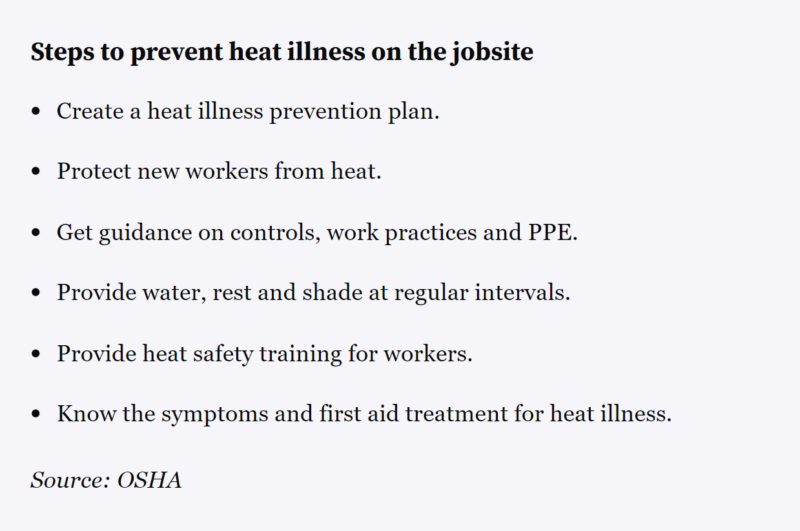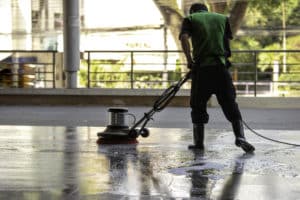The heat is on. Contractors say they’re ready.
Summer may not officially start until June 20, but the heat is here.
More specifically, areas in the Western U.S. saw temperatures hit triple digits for the first time this year, as a large heat dome descended over the area, creating sweltering conditions and increasing the risk of wildfires. About 27 million people face scorching temperatures across California, Nevada, Utah and Arizona, according to Axios.
But construction industry leaders say they are prepared for the extreme temperatures like those states feel this week and that this summer will bring. They have plans to beat the heat, educate teams and keep workers cool.
Plans, posters and shifting schedules
Safety measures begin with understanding the problem, experts say. Extreme heat can lead to a range of accidents and injuries beyond heat illness.
“Data indicates workplace injuries surge during the summer season,” said Paul Haining, chief environmental safety and health officer for Skanska USA. “We assess these heightened risks through our construction work plans and daily hazard analysis, prioritizing the mitigation or elimination of the hazard.”

Those tactics include education around heat illness prevention, timed work rotations, cooling stations and hydration zones and even an analysis of vacation scheduling to ensure tasks are properly covered, Haining said.
“Every contract, every job that we have, climate is taken into account when we’re building that job out,” Steve Spaulding, vice president and chief environmental health and safety officer for Turner, the country’s largest contractor by revenue.
Turner’s approach includes knowing which of its jobsites face high temperatures on any given day and adding fans, misters and tents to provide water breaks.
On one project in San Diego, Turner took a creative approach to helping workers assess their hydration level on bathroom breaks.
“It sounds funny to talk about, but it had a urine color chart. So it was posted where you were looking,” Spaulding said, so workers could compare and see if they needed to hydrate.
Even with those protections in place, workers can still suffer in the heat, experts say, which is part of why education is so important. Federal guidance recommends easing workers into the heat, as most heat illness injuries take place in the first week of work, according to OSHA.
“The vast majority of us never really acclimate,” said Greg Sizemore, vice president of workforce development for Associated Builders and Contractors. “What contractors are doing across the civil trades is they’re modifying their schedule to work in the cool of the evening or early in the morning before it gets too doggone hot out there.”
Frank Trujillo, vice president of safety for Bethesda, Maryland-based Miller & Long Concrete Construction, also believes shifting work hours is a good solution.
“If I could snap my fingers and change one thing, it would be that everybody out there who’s concerned about the plight of the construction worker would also be willing to maybe put aside some of their personal concerns and allow these workers to work overnight where it’s cooler,” he said.

The cost of health and safety resources — such as the misters and cooling stations — is hardly a factor, Turner’s Spaulding said.
“The benefits of it way outweighs any implication of what a cost could be,” he said.
Sizemore pushed against a thinking of safety in any regard with a budget mindset.
“We’ve got to really begin to use different words there. This is not an expense. This is not a cost to a contractor. This is an investment into workforce development,” Sizemore said. “You can’t afford not to.”
And it’s never too early to prepare workers for the heat to come. Trujillo says his teams start the educating process in March.
“You’re getting everyone in that mindset of what’s to come. These are the symptoms,” he said, though there is an important line to toe when it comes to informing workers of potential underlying health threats without violating their private medical history. “One of the biggest issues is understanding how people’s decisions can expose them to heat risk.”
In an odd bit of silver lining, Trujillo said, the pandemic helped educate the general public about underlying conditions that may make them more susceptible.
“Leave it to a safety guy to come out with a positive out of COVID,” he said.
https://www.constructiondive.com/news/contractors-heat-safety-tips-summer/718110/



